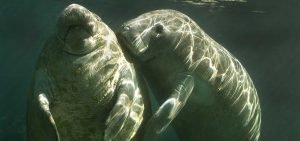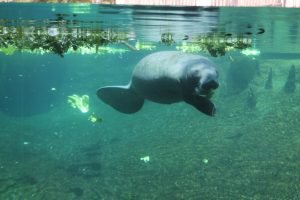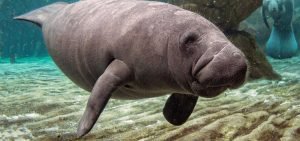See Manatees in Naples Florida
January 26, 2022

Manatees roam the waters of southeast Florida from April through October—but when things get a bit chilly, they head to places like freshwater Florida springs, where the temperatures remain constant throughout the year.
It may not seem warm when you jump into a freshwater spring, but the water temperatures remain around 70 degrees, which is perfect for manatees in Florida who need that kind of warmth to survive.
Seeing a large number of Florida manatees in one place is an amazing experience, but just remember these gentle sea cows are there for survival. Whether you’re on a solo kayaking trip or a manatee swim tour, always mind your “Manatee Manners”— look, but don’t touch.
The U.S. Fish and Wildlife Service has produced several videos on interacting with manatees, whether it’s by swimming/snorkeling, boating or kayaking. There’s even information that’s specifically for photographers and videographers.
Remember to respect these precious creatures and the environment in which they live. Naples provides one of the best places to see manatees in their environment. We offer manatee eco-tours and an experienced staff who will take you to see the manatees, while offering important information regarding manatees and their habitat.
The Purpose of Ecotourism
January 19, 2022

Most tourism in natural areas today does not fall under the category of ecotourism and is not, therefore, sustainable. Ecotourism is set apart by its emphasis on conservation, education, traveler responsibility and active community participation.
With the many advances in transportation and information technology, even the most remote places on our earth are within reach of the traveler. In fact, tourism is now the world’s largest industry, with nature tourism representing the fastest growing segment. People express a desire to experience nature and the world, but should make every attempt to do so in a way that does not negatively impact the natural environment.
The World Conservation Union (IUCN) defines ecotourism as, “Environmentally responsible travel to natural areas, in order to enjoy and appreciate nature (and accompanying cultural features, both past and present) that promote conservation, have a low visitor impact and provide for beneficially active socio-economic involvement of local peoples.”
Ecotourism generally possesses the following characteristics:
- Conscientious, low-impact visitor behavior
- Sensitivity towards, and appreciation of, local cultures and biodiversity
- Support for local conservation efforts
- Sustainable benefits to local communities
- Local participation in decision-making
- Educational components for both the traveler and local communities
Increased tourism to sensitive natural areas without appropriate planning and management can threaten the integrity of ecosystems and local cultures. An increase of visitors to sensitive natural areas can lead to substantial environmental degradation. Local communities and indigenous cultures can also be harmed by a large influx of visitors. Ecotourism offers an opportunity for an increase in education and activism among travelers, making them more effective supporters of conservation.
Keeping Manatees Safe in Florida Waters
January 12, 2022

Living in harmony with the natural environment is a challenge in Florida, which has undergone more growth in human population and infrastructure than the majority of other regions throughout the United States. For several decades this growth has impacted indigenous plant and animal life through habitat loss or alteration, decreased water quality, increases in airborne pollutants, and introduction of invasive species. In the case of Florida manatees, habitat alteration has included harmful algal blooms such as red tide that have resulted in hundreds of sick and dead manatees. These blooms may be exacerbated by groundwater runoffs high in nitrates and phosphorus that are often caused by human activities including septic tank leakage and the use of manufactured fertilizers.
Manatees in Florida deal with motorized boat traffic throughout much of their range. Florida has about 2000 miles of complex coastline involving the Intracoastal Waterway, numerous rivers, creeks, canals, bays, lagoons, inlets, lakes, and coastal islands. Manatees are found in each of these habitats because they feed on a wide variety of aquatic vegetation. The number of registered boats in Florida has increased significantly along with the expanding human population, and is directly correlated with increasing manatee mortality from strikes by boats.
Studies of manatee hearing have been done on wild and captive manatees. In controlled experiments, manatees have been observed to detect and avoid single boats traveling at a variety of speeds, as long as they have adequate time to respond. However, the presence of many boats in one area generates a complicated mixture of sounds that make it difficult if not impossible to detect a specific boat that may pose a threat.
Reduced speed zones have been implemented at designated locations in 18 Florida counties, focused on areas where manatees are known to be abundant. They include portions of over 20 major rivers, but constitute only a very small fraction of the total amount of navigable waterways used by manatees in Florida. Depending upon the specific location, restrictions include no entry, idle speed, slow speed, and 25, 30 or 35 mph limits. Some restrictions apply year-round, others during specific months.
The premise of establishing slow boat speed zones for manatee protection is that vessels moving at slower speeds allow both the vessel operator and the manatee more time to respond to avoid a collision. In the event that a collision occurs, less severe injuries occur if a vessel is moving at a slower speed. Even moderate reductions in the speed at which an impact occurs can dramatically lessen the potential for injuries or death since the resultant force of impact is reduced.
Several studies have found that only about 60% of boaters comply with posted slow speeds. Not surprisingly, the presence of law enforcement results in greater compliance. However, the number of marine patrol officers is very low compared to what would be needed to have a widespread effect on boater compliance. For now, low boater compliance and an increasing number of boats are two factors that contribute to sustained high numbers of manatees killed by boat strikes. Technological solutions have been proposed, including warning lights to notify boaters of manatees in an area, and sound beacons on boats to warn manatees of boaters in an area.
While traveling waterways known to have manatees it is important to follow speed limits and lookout for these majestic creatures. Have a dedicated spotter on board and looking for large shadows and circular wave patterns left on the surface of the water by the manatee’s tail. Polarized sunglasses help.
One of the pleasures of being in Florida is seeing manatees in their natural habitat, either from your boat, by kayak tour, or on a snorkeling trip. We are a responsible eco tour company that works to ensure that all human/manatee interaction is conducted in a safe, non-stressful, and considerate manner and we believe that we can increase safety for manatees by sharing our knowledge and sharing the beauty of the majestic manatees with you.
Manatee Facts
January 5, 2022

Here are some Manatee Facts:
- Manatees are marine mammals.
- Manatees are also known as sea cows.
- Manatees are gentle, non-aggressive animals.
- There are three species of manatees: West Indian Manatees (Trichechus Manatus), West African Manatees (Trichechus Senegalensis), Amazonian or South American Manatees (Trichechus Inunguis).
- There are also two sub-species of manatees: Antillean Manatee (Trichechus Manatus Manatus) and Florida Manatee (Trichechus Manatus Latirostris).
- Manatees mainly live in shallow (3ft-10ft) rivers, saltwater bays, canals and marshy costal areas.
- Amazonian manatees live in freshwater.
- Manatees cannot survive in water temperatures below 60 degrees.
- They live in the Gulf of Mexico, Caribbean Sea, Amazon Basin and West Africa.
- Adult manatees can grow to be 9ft-13ft long.
- On average manatees weigh between 800-1,300 pounds. There have been manatees that weighed up to 3,000 pounds!
- Manatees live to be between 40-60 years old.
- Manatees are gray.
- They have two paddle like flippers one on each side of their body and a big flat tail.
- The West Indian and West African Manatees have 3-4 nails on each flipper.
- The flippers help them steer while swimming. Manatees also use their flippers to help them eat.
- They swim by moving their flat tail up and down.
- While swimming sometimes manatees will do flips underwater, roll around and even swim upside down.
- Since manatees are mammals they cannot breathe underwater.
- Manatees usually come up for air every 3-4 minutes but have been known to hold their breath for up to 20 minutes.
- Manatees are slow swimmers. They usually swim between 3-5 mph. They can swim up to 20mph for very short distances.
- Manatees spend most of their time eating, resting or traveling.
- Manatees are herbivores meaning they only eat plants although at times manatees will eat small fish.
- Manatees eat turtle grass, different types of algae, water hyacinth and other types of plants in the water.
- Manatees have a large flexible lip that they use to help them eat.
- Manatees eat around 100 pounds of food every day!
- Manatees travel between 40-50 miles every day!
- Manatees have two small eyes one on each side of their head. Even though they have small eyes manatees have good eyesight.
- Manatees cannot move their neck from side to side. To see behind them they must turn their entire body!
- Manatees also have good hearing. They have no earlobes on the outside of their head but two inner lobes one on each side of their head.
- Manatees have 24-32 molars located in the back of their mouths. When their molars get worn down from when they eat, new teeth (molars) grow in.
- Mom manatees are pregnant for around 12-13 months.
- Baby manatees are called calves.
- Mom manatees only give birth to one manatee at a time.
- When a calf is born the mother manatee brings him/her to the surface to breath.
- Calves live with their mom for two years.
- Manatees spend most of their time alone however, they have been known to interact with other manatees and even play with them. They like to bodysurf with other manatees.
- Manatees will communicate with other manatees by making chirping, whistling and squeaking sounds. They also make these sounds when they are scared.
- Manatees have a good sense of smell.
- It is illegal to hunt them.
- The only known predator to a manatee is a human.
- Manatees often die from getting hit by boats.
- Manatees also suffer from loss of habitat.
- Like dolphins, manatees are smart can be trained to learn tricks.